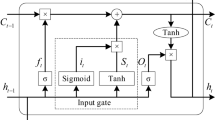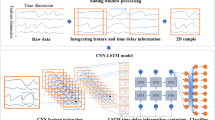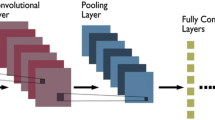Abstract
The deep-learning networks for bearing fault diagnosis may encounter ambient noise interference. The inherently feedforward serial structure lacks the suppression of the ambient noise involved in bearing data. Moreover, the accuracy of the diagnosis model relies on training a large amount of labeled data, thus resulting in a significant amount of time consumption. To combat these two challenges, an improved capsule network diagnosis model with a long short-term memory filter (LF-iCapsNet) is proposed. First, the LSTM network is used to filter out the noise interference in the time domain through a nonlinear moving-average mechanism. At the same time, a subsequent feature-extraction convolution with large kernels is employed to specifically suppress the noise in the frequency domain, where a dilated convolution is adopted to achieve multi-scale feature extraction. Second, to obtain the distance-dependent relations of low-level features, an inner dependence operator is introduced into the primary capsule. Thus, a richer and more complete feature description of the bearing fault is guaranteed. And so, the derived digital capsule gives a geometrical constraint representation among the pixels in the feature maps and a rather high-speed training process because of its one-stage detection mode. Finally, the proposed LF-iCapsNet model is validated on the dataset from Case Western Reserve University (CWRU). The experimental results show that the diagnosis model provides a considerable improvement in the classification accuracy of bearing faults under the noise condition.




Similar content being viewed by others
Explore related subjects
Discover the latest articles, news and stories from top researchers in related subjects.References
Qian, Q., Qin, Y., Wang, Y., Liu, F.: A new deep transfer learning network based on convolutional auto-encoder for mechanical fault diagnosis. Measurement 178, 109352 (2021)
Zheng, Z., Zhang, Z., Wang, L., Luo, X.: Denoising temporal convolutional recurrent autoencoders for time series classification. Inf. Sci. 588, 159–173 (2022)
An, Z., Li, S., Wang, J., Jiang, X.: A novel bearing intelligent fault diagnosis framework under time-varying working conditions using recurrent neural network. ISA Trans. 100, 155–170 (2020)
Zhang, Y., Zhou, T., Huang, X., Cao, L., Zhou, Q.: Fault diagnosis of rotating machinery based on recurrent neural networks. Measurement 171, 108774 (2021)
Elhoseny, M., Shankar, K.: Optimal bilateral filter and convolutional neural network based denoising method of medical image measurements. Measurement 143, 125–135 (2019)
Tang, L., Xuan, J., Shi, T., Zhang, Q.: EnvelopeNet: A robust convolutional neural network with optimal kernels for intelligent fault diagnosis of rolling bearings. Measurement 180, 109563 (2021)
Zhang, X., Liu, S., Li, L., Lei, J., Chang, G.: Multiscale holospectrum convolutional neural network-based fault diagnosis of rolling bearings with variable operating conditions. Meas. Sci. Technol 32(10), 105027 (2021)
Li, G., Deng, C., Wu, J., Chen, Z., Xu, X.: Rolling bearing fault diagnosis based on wavelet packet transform and convolutional neural network. Appl. Sci. 10(3), 770 (2020)
Tian, Y., Liu, X.: A deep adaptive learning method for rolling bearing fault diagnosis using immunity. Tsinghua Sci. Technol. 24(6), 750–762 (2019)
Han, T., Zhang, L., Yin, Z., Tan, A.: Rolling bearing fault diagnosis with combined convolutional neural networks and support vector machine. Measurement 177(1), 109022 (2021)
Chen, X., Zhang, B., Gao, D.: Bearing fault diagnosis base on multi-scale CNN and LSTM model. J. Intell. Manuf. 32, 1–17 (2020)
Alex, S., Martin, H.: A novel deep learning model for the detection and identification of rolling element-bearing faults. Sensors 20(18), 1–24 (2020)
Zhuang, Z., Lv, H., Xu, J., Huang, Z., Qin, W.: A deep learning method for bearing fault diagnosis through stacked residual dilated convolutions. Appl. Sci. 2019, 9 (1823)
Yu, L., Qu, J., Gao, F., Tian, Y.: A novel hierarchical algorithm for bearing fault diagnosis based on stacked LSTM. Shock Vib. 2019, 1–10 (2019)
Zhang, T., Liu, S., Wei, Y., Zhang, H.: A novel feature adaptive extraction method based on deep learning for bearing fault diagnosis. Measurement 185, 110030 (2021)
Zhao, M., Zhong, S., Fu, X., Tang, B., Pecht, M.: Deep residual shrinkage networks for fault diagnosis. IEEE Trans. Industr. Inf. 16(7), 4681–4690 (2020)
Zhu, Z., Peng, G., Chen, Y., Gao, H.: A convolutional neural network based on a capsule network with strong generalization for bearing fault diagnosis. Neurocomputing 323, 62–75 (2019)
Liang, Y., Li, B., Jiao, B.: A deep learning method for motor fault diagnosis based on a capsule network with gate-structure dilated convolutions. Neural Comput. Appl. 33, 1404–1418 (2021)
Chen, Y., Zhang, D., Zhang, H., Wang, Q.: Dual-path mixed domain residual threshold networks for bearing fault diagnosis. IEEE Trans. Ind. Electron. (2022). https://doi.org/10.1109/TIE.2022.3144572
Liu, J., Zhang, C., Jiang, X.: Imbalanced fault diagnosis of rolling bearing using improved MsR-GAN and feature enhancement-driven CapsNet. Mech. Syst. Signal Process. 168, 108664 (2022)
Liu, Y., She, G., Chen, S.: Magnetic resonance image diagnosis of femoral head necrosis based on ResNet18 network. Comput. Methods Programs Biomed. 208, 106254 (2021)
Hendriks, J., Dumond, P., Knox, D.: Towards better benchmarking using the CWRU bearing fault dataset. Mech. Syst. Signal Process. 169, 108732 (2022)
Zhang, D., Chen, Y., Guo, F., Karimi, H.R., Dong, H., Xuan, Q.: A new interpretable learning method for fault diagnosis of rolling bearings. IEEE Trans. Instrum. Meas. 70, 1–10 (2020)
Funding
This work was supported by Scientific and Technological Research Projects in Henan Province, 222102210274, Xinliang Zhang, 212102210244, Xinliang Zhang, Foundation of Henan Educational Committee, 21A120004, Xinliang Zhang, Fundamental Research Funds for the Universities of Henan Province, NSFRF210305, Xinliang Zhang.
Author information
Authors and Affiliations
Corresponding author
Additional information
Publisher's Note
Springer Nature remains neutral with regard to jurisdictional claims in published maps and institutional affiliations.
Rights and permissions
Springer Nature or its licensor holds exclusive rights to this article under a publishing agreement with the author(s) or other rightsholder(s); author self-archiving of the accepted manuscript version of this article is solely governed by the terms of such publishing agreement and applicable law.
About this article
Cite this article
Zhang, X., Kong, J., Zhao, Y. et al. A deep-learning model with improved capsule networks and LSTM filters for bearing fault diagnosis. SIViP 17, 1325–1333 (2023). https://doi.org/10.1007/s11760-022-02340-x
Received:
Revised:
Accepted:
Published:
Issue Date:
DOI: https://doi.org/10.1007/s11760-022-02340-x




